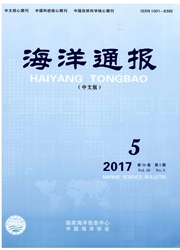

 中文摘要:
中文摘要:
利用近5年的Argo剖面序列,通过经验正交函数(EOF)分析,分析了南海北部海域声速垂直结构的时空变化特征和声速场水平分布特征。分析表明:EOF的前6个模态反映了海区声速结构的主要变化,可以很好地表示声速剖面。第1模态具有明显的年变化周期,主要受海洋混合层季节性变化影响;第2模态与第1模态时间函数具有明显的反向变化特征,主要对次表层进行调制;第3模态主要影响次表层以下声速变化;表层声速分布与深层声速分布有明显的差异,表层声速主要受海水温度变化的影响,深层声速分布与南海环流系统关系密切;冷涡的存在会引起声速场的低值中心。
 英文摘要:
英文摘要:
Based on the Argo profile data of nearly 5 years, the spatial-temporal variation characteristics of sound speed profiles in northern South China Sea were analyzed by Empirical Orthogonal Function (EOF), and then the sound speed characteristics for different depths were obtained by interpolating the scattered Argo sound speed data into regular gridded data. The results were shown as follows: The first 1-6 modes reflected the main features of the sound speed structure. The first mode, with an obvious year cycle, was closely related to the mixed layer. The second mode, with a phase contrary to the first mode, mainly worked in the subsurface. The third mode mainly affected the layers beneath the subsurface. The horizontal distributions of sound speed were different at each depth, and the sound speed at surface was notably influenced by water temperature while the sound speed below the surface was closely relative to the circulation system and water mass displacement. Cold eddy caused low sound speed zones. Both the Luzon cold eddy and the Vietnam cold eddy caused low sound speed zones.
 同期刊论文项目
同期刊论文项目
 同项目期刊论文
同项目期刊论文
 期刊信息
期刊信息
